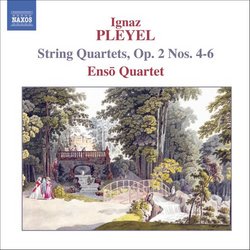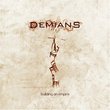| All Artists: Ignaz Pleyel, Enso Quartet Title: Pleyel: String Quartets Op.2 #4-6 Members Wishing: 0 Total Copies: 0 Label: Naxos Original Release Date: 1/1/2006 Re-Release Date: 2/21/2006 Genres: Jazz, Special Interest, Classical Styles: Swing Jazz, Marches, Chamber Music, Historical Periods, Classical (c.1770-1830) Number of Discs: 1 SwapaCD Credits: 1 UPC: 747313249725 |
Search - Ignaz Pleyel, Enso Quartet :: Pleyel: String Quartets Op.2 #4-6
 | Ignaz Pleyel, Enso Quartet Pleyel: String Quartets Op.2 #4-6 Genres: Jazz, Special Interest, Classical
|
Larger Image |
CD DetailsSimilar CDs
|
CD ReviewsMore Early Pleyel Quartets, Beautifully Played and Recorded J Scott Morrison | Middlebury VT, USA | 02/22/2006 (5 out of 5 stars) "[For background information on these quartets and on the Enso Quartet, please refer to my review of the Pleyel Op. 2, Nos. 1-3 Quartets released a couple of months ago and available at http://www.amazon.com/gp/product/B000BRJXZU/ ]
Here we have the rest of the quartets from Pleyel's Op. 2, a set of six quartets from early in his career. Pleyel was born one year after Mozart in 1757 and outlived Beethoven and Schubert, dying in 1831. He studied with Haydn and his music reflects that to some degree but he went his own way and some musicologists suggest that his music represents a bridge between the music of Haydn and that of Beethoven and Schubert. What is important to remember is that he was a composer of excellent music which was exceedingly well regarded in his day. However his career tended, later in life, to that of the impresario and manufacturer of harpsichords and pianos. There is to this day a famous hall in Paris, Salle Pleyel, the site of many important musical events over the years. These three quartets from 1784 are all in three movements, already at variance with Haydn's four-movement model. The slow movements are played con sordini (muted strings). There is a definite Italian tinge to his melodies and procedures, although he is not above using such Haydn tricks as misdirecting us into believing a repeat is about to occur when, instead, the music veers off in a new direction (as in the Fifth Quartet's first movement). These are entirely delightful works and they are given impressive readings by the young Enso Quartet, four musicians who met and formed the group while studying at Yale. This volume is a welcome companion to the earlier issue with the first three quartets of this opus number. Scott Morrison" |

 Track Listings (10) - Disc #1
Track Listings (10) - Disc #1
